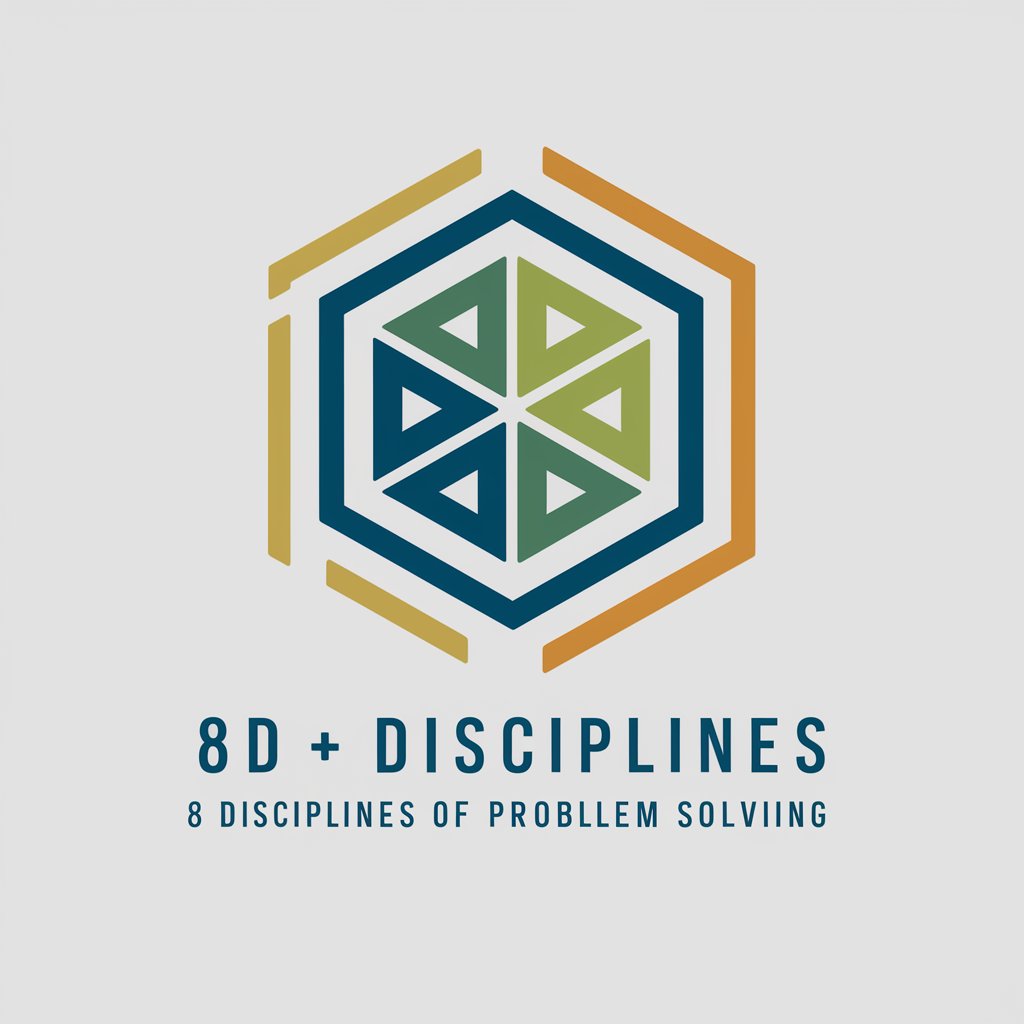8D+ 8 Disciplines Of Problem Solving - AI-Powered Problem Solving

Welcome! Let's master the 8 disciplines of problem-solving together.
AI-Driven Solutions, Structured Success
Describe the root cause of the problem and how it was identified...
What interim actions were taken to contain the problem...
Explain the corrective actions implemented to prevent recurrence...
How will the effectiveness of the solution be validated...
Get Embed Code
Introduction to 8D+ 8 Disciplines Of Problem Solving
The 8D+ 8 Disciplines of Problem Solving is an analytical approach designed to address complex issues systematically and effectively. Originating in the automotive industry and now widely applied across various sectors, its purpose is to identify, correct, and eliminate recurring problems, enhancing product quality and customer satisfaction. The process integrates team synergy and provides a guideline to find the root cause of a problem, develop containment actions, implement permanent solutions, and prevent recurrence. For example, in a manufacturing setting, when a product failure occurs, the 8D+ process would be initiated to systematically identify and fix the production issue, ensuring the problem doesn't recur and improving overall operational efficiency. Powered by ChatGPT-4o。

Main Functions of 8D+ 8 Disciplines Of Problem Solving
D1: Team Formation
Example
Gathering a cross-functional team with the necessary skills and authority to solve the problem.
Scenario
In an automotive company, a team is formed including members from engineering, quality, and production to address a specific issue with vehicle door alignment.
D2: Problem Description
Example
Defining the problem in measurable terms and understanding its impact.
Scenario
A software development team uses D2 to clearly articulate a bug causing app crashes, affecting 30% of users.
D3: Interim Containment Action
Example
Implementing temporary solutions to stop the problem's immediate effects.
Scenario
A food processing plant discovers a contamination issue and immediately halts production in the affected line to prevent further product compromise.
D4: Root Cause Analysis
Example
Using tools like 5 Whys or Fishbone diagrams to drill down to the problem's origin.
Scenario
An electronics manufacturer identifies a flaw in the soldering process as the root cause of frequent circuit board failures.
D5: Permanent Corrective Actions
Example
Developing and implementing solutions that address the root cause of the problem.
Scenario
After identifying a critical design flaw in a consumer product, the design team redesigns the affected component to eliminate the flaw.
D6: Implement and Validate Corrective Actions
Example
Ensuring the corrective actions have resolved the problem without causing additional issues.
Scenario
A telecom company rolls out a software update to fix a network vulnerability and conducts extensive testing to confirm the issue is resolved.
D7: Prevent Recurrence
Example
Modifying policies, procedures, and standards to prevent the problem from happening again.
Scenario
A hospital updates its patient intake procedures after a D7 analysis to prevent miscommunication errors.
D8: Congratulate Your Team
Example
Acknowledging the efforts of the team and sharing the success with the organization.
Scenario
Upon successful resolution of a critical delivery issue, a logistics company holds a team celebration to recognize the team's hard work and success.
Ideal Users of 8D+ 8 Disciplines Of Problem Solving Services
Quality Assurance Professionals
Individuals responsible for maintaining standards in products or services. They can leverage 8D+ to systematically address quality issues, ensuring compliance and customer satisfaction.
Project Managers
Leaders who oversee projects from inception to completion. They can use 8D+ to solve project-related problems efficiently, ensuring projects are delivered on time, within budget, and to the required quality standards.
Manufacturing Engineers
Engineers focused on the design, operation, control, and optimization of manufacturing processes. They benefit from using 8D+ to identify and solve production issues, increasing efficiency and reducing waste.
Customer Service Managers
Professionals who ensure customer satisfaction and manage customer-related issues. They can apply 8D+ to resolve complaints effectively, improving customer loyalty and company reputation.

Using 8D+ 8 Disciplines Of Problem Solving
1
Visit yeschat.ai for a complimentary, login-free trial, also bypassing the need for ChatGPT Plus.
2
Identify the problem you wish to solve. Be as specific as possible, considering the context and scope of the issue.
3
Utilize the interactive 8D process by sequentially answering guided questions for each discipline, from D2 (Problem Description) to D8 (Closure and Congratulation).
4
Critically review and validate responses to ensure they are thorough, align with the 8D methodology, and meet the VDA standard.
5
After completing all steps, use the tool to generate a formatted 8D report, which will consolidate your findings and solutions.
Try other advanced and practical GPTs
Steve Urban's Career Coaching, by Riderflex
Empowering Your Career with AI

Recruiting Business Owner
Empowering Recruitment with AI

RecruitingCoPilot (Active Sourcing)
Streamlining Recruitment with AI

Empty Fridge Recipes
Turn scant supplies into savory meals

HIXOS - Synthèse de CV
Transform Your CV with AI Insight

Emye Copilote RH
AI-powered HR Solutions at Your Fingertips

Kubernetes Cloud Engineer
Empowering Kubernetes Management with AI

Business English Material Creator
Craft Realistic Business English Scenarios with AI

Discover Connecticut
Tailoring Your Connecticut Journey with AI

Breed Scout
Discover Dog Breeds with AI

Your Founder Coach
Empowering Founders with AI-Powered Coaching

💡Ai4Med : Research Assistant 🧠
Empowering Medical Discovery with AI

Frequently Asked Questions about 8D+ 8 Disciplines Of Problem Solving
What is the 8D+ problem-solving process?
8D+ is an enhanced problem-solving approach based on the original 8 Disciplines methodology. It guides users through a structured process to identify, analyze, and resolve problems, ensuring robust solutions.
How can 8D+ help in a manufacturing context?
In manufacturing, 8D+ helps in systematically diagnosing issues, implementing temporary fixes, identifying root causes, and developing permanent solutions to prevent recurrence, thereby improving quality and efficiency.
Can 8D+ be applied in service industries?
Absolutely, 8D+ is versatile and can be adapted to service industries. It assists in analyzing service failures, improving customer satisfaction, and enhancing service delivery through systematic problem resolution.
What makes 8D+ different from traditional 8D?
8D+ builds on traditional 8D by incorporating additional AI-driven insights and analytics, providing a more comprehensive and data-driven approach to problem-solving.
Is prior experience in problem-solving required to use 8D+?
While prior experience can be beneficial, 8D+ is designed to be user-friendly, guiding users of all levels through the problem-solving process with structured questions and analyses.
